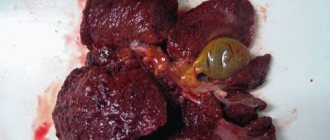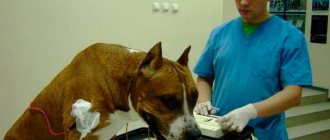Hepatitis in dogs (Rubart's disease) is a dangerous infectious disease. The most serious way this disease harms the dog’s body is the monstrous load on the liver, and this organ, as you know, performs the most important functions. Today we will talk about how to recognize the first signs of canine hepatitis, what measures to take, and we will tell you what therapy is prescribed for this disease and what are the pet’s chances of recovery.
Hepatitis in dogs: symptoms and treatment
General information about canine hepatitis
Hepatitis in dogs, like in humans, is associated with the entry into the body of the adenovirus CA VI, which spreads with lightning speed through living tissues and cells, affecting almost all organs. But the heaviest blow falls on the liver: this organ begins to become seriously inflamed and then necrotic under the influence of this virus. Accordingly, the disease itself is not as terrible as its consequences.
The liver, suffering from degenerative changes, begins to break down and ceases to perform its functions. The dog begins to suffer from intoxication of the body, and in advanced cases it may die from a malfunction of the nervous system, from kidney failure or hepatic coma. In addition, hepatitis provokes bleeding in the gastrointestinal tract, which can also be fatal for the pet.
Dog liver infected with adenovirus
The term "hepatitis" stands for inflammation of the liver. Like any inflammatory process, hepatitis is characterized by a massive, strong blood flow to the organ, which severely impairs its functioning. Depending on the type of illness, the animal will experience additional problems.
Types and forms of hepatitis in dogs
Hepatitis in dogs has two forms. The worst is fulminant, when the virus instantly spreads throughout the body within a few hours. The owner may not even have time to come home from work or react to the lethargy of the pet before death occurs. The second form of hepatitis is chronic, treatable, and the complexity of therapy and the duration of the recovery period depend on the age and general health of the animal, as well as the severity and type of the disease itself.
The most dangerous is the fulminant form of hepatitis.
Table. Types of canine hepatitis
| Infectious | Toxic |
| The most common illness caused by adenovirus entering the body. The disease can strike an animal at any age, but puppies and young dogs are more often affected. | This type of hepatitis is caused by the accumulation of toxins in the liver, most often the disease is associated with long-term use of medications, poisoning or poor-quality diet |
Dogs of any age can get hepatitis.
How can an animal get hepatitis?
Veterinarians report that hepatitis is a disease that occurs in almost every third dog. First of all, damage and inflammation of the liver occurs due to an illiterate or poorly designed diet of the animal. Not every owner is willing to spend time and money to ensure that their dog receives fresh and balanced food. As a result, dogs that eat low-quality cheap dry food, receive food from the human table, or are completely content with leftovers, often suffer from toxic hepatitis.
Another factor that provokes toxic, or, as it is otherwise called, drug-induced hepatitis, is the uncontrolled treatment of an animal with various drugs, in particular antibiotics. Indeed, modern antibiotics can cure a lot of diseases, but a long course, incorrect dosage and other flaws in taking medications simply “damage” the animal’s liver.
Any veterinary medications should be prescribed only by a qualified specialist!
The danger of unauthorized prescription of drugs to an animal concerns not only antibiotics, but also products containing steroids or hormones. In addition, the wrong dosage of any drug can have a detrimental effect on your pet’s liver, so it is strictly forbidden to give your dog any medication without a veterinarian’s prescription!
Toxic hepatitis occurs due to the fact that toxic substances enter and accumulate in the animal’s body for a long time. These are not necessarily medications: poisoning can be caused by chemicals, expired or missing food, as well as products of their decomposition. If a dog lives for a long time in unfavorable conditions (for example, in an area where repairs are regularly carried out, fuel is spilled) or constantly inhales chemical or exhaust gases, liver damage will not be long in coming.
In the wrong dose, medicine becomes poison
Hepatitis is also caused by intestinal parasites that seem so harmless to many people. Helminths, accumulating in the dog’s body, parasitizing in the intestines and other internal organs, release so many toxic substances that they put a significant burden on the liver. If the infection with helminths is extensive, then toxic damage and inflammation of the organ will occur quite quickly. This condition is especially dangerous for puppies, who can die from intoxication in a matter of days.
A tick bite can cause serious liver problems.
A dog's liver can also be damaged by another blood-sucking parasite. We are talking about ticks, which, when they bite into an animal, can introduce piroplasm into the blood - a microscopic pest that affects the circulatory system. Piroplasmosis is already deadly for dogs at any age, and if liver inflammation, that is, hepatitis, is added to it, then the pet’s chances of survival are extremely low.
Methods of protection against ticks
Infectious hepatitis is caused only by an adenovirus, which is transmitted from a sick dog to a healthy one. It is enough for animals to play together for infection to occur. Please note that this virus only affects members of the canine family and is not contagious to humans or other animals. Simply put, a dog that has contracted hepatitis of any kind, be it toxic or infectious, is under no circumstances dangerous to the owner and his family members.
Important point! Dogs cannot infect each other with toxic hepatitis, as it is caused by environmental factors. But infectious hepatitis is extremely dangerous, and a pet with such a disease should be walked alone.
A sick dog should not have contact with other dogs.
How can you tell if your dog has hepatitis?
Depending on the phase and form in which hepatitis occurs in an animal, the symptoms of the disease will differ. Each form has specific symptoms, but there are also general symptoms that clearly indicate that the pet is unwell.
Thus, hepatitis of any kind is indicated by an increase in body temperature, lack of appetite against the background of persistent thirst, apathy and a depressed appearance. The dog is not pleased with either the owner’s attention or the upcoming walk. Hepatitis also has a manifestation specific to any form: the pet tries to lie on its left side, and when palpating the right hypochondrium, it breaks out, squeals or whines. If you still palpate this area, you will find that the liver is greatly swollen and increased in size.
Fever and refusal to eat are extremely alarming symptoms
If we talk about acute infectious hepatitis, which develops rapidly, then the following symptoms will be characteristic:
- The dog is lethargic, tries to lie down more, and does not respond to stimuli.
- There is no appetite, but the animal experiences constant thirst.
- The dog is breathing frequently, there is nasal congestion, and enlarged lymph nodes under the jaw.
- Repeated diarrhea with mucus and blood, vomiting mixed with bile and blood.
- The body temperature rises to 40-42 degrees, the urine becomes dark brown, and numbness and weakness of the limbs are possible.
- The eyes become cloudy, glassy, and the mucous membranes acquire a jaundiced tint.
- In severe cases, bleeding from the mouth or nose and bleeding gums are observed.
Yellowness of the oral mucosa
With chronic hepatitis of an infectious type, the symptoms change, acquiring more serious consequences for the body. Since chronic hepatitis develops over weeks, the signs will be appropriate:
- Problems with stool, gas formation in the intestines, periodic vomiting.
- Loss of body weight, slight increase in body temperature.
- Swelling, cramps, fever, worsening in the evening.
- Numbness, necrosis of muscle tissue.
- Periodic photophobia, clouding of the eyeball, disorientation in space.
These symptoms are not as striking as those of acute infectious hepatitis, so they are more difficult to identify. However, if the animal has changed its behavior, is reluctant to eat or reacts sluggishly to affection and attention, this is a reason to take it to the veterinarian.
Detecting the disease in time increases the chances of successful treatment for your pet.
About clinical symptoms
The first warning sign that a dog owner should be concerned about is a sudden change in his dog's behavior. Having become apathetic and lethargic, the pet suddenly loses all interest in its favorite games and food. He prefers to lie, and exclusively on his left side. This is a serious reason to contact a veterinarian.
Hepatitis is an insidious disease that most young dogs under the age of twelve months suffer in a mild form, and their owners do not even notice it. This explains the fact that 75% of adult dogs have acquired immunity to hepatitis of viral etiology. For dogs not included in this number, infectious hepatitis is extremely difficult to tolerate; For puppies under one year of age, the disease is often fatal. The incubation period does not exceed eight days.
Typical symptoms indicating liver damage include:
- A significant increase in its volume. This becomes clear when palpating the right hypochondrium. The dog, experiencing severe pain, begins to squeal and whine.
- Yellowness of all mucous membranes and whites of the eyes.
- Whitish coloration of stool.
- Dark colored urine with an unpleasant odor.
- Attacks of vomiting.
- Diarrhea (liquid stool turns dark yellow).
- Swelling of the head, neck and increase in the volume of the tonsils. Swollen tonsils make swallowing difficult, so from the outside it may seem that your pet is constantly choking on food.
- Arrhythmic (intermittent or rapid) heartbeat.
- The appearance of a whitish film (often called “blue eye” syndrome), covering one or both eyeballs and spontaneously disappearing after a few days.
- A sharp increase in body temperature to values exceeding 40 degrees.
- The appearance of convulsions and paralysis of the limbs (this symptom is typical for puppies).
Hepatitis, which occurs in an acute form, is accompanied by pronounced symptoms; In chronic cases, the clinical picture of the disease is characterized by blurred and inconspicuous manifestations.
Making a correct diagnosis is impossible without a blood test, since only its characteristics make it possible to differentiate hepatitis from a number of diseases (such as lung infections and plague) that have similar symptoms.
How is hepatitis diagnosed in dogs?
It is impossible to determine that a dog is sick with hepatitis “by eye”, since the symptoms of this disease are extremely similar to other infectious diseases: enteritis, distemper and the like. Therefore, the veterinarian, having learned from the owner all the information about the animal’s condition and unpleasant symptoms, must conduct a series of studies. So, it is necessary to take blood and urine tests, as well as undergo an ultrasound of the liver and laboratory diagnostics of biological fluids (saliva, vomit, etc.). If the test results give signs differentiated from other diseases (for example, hepatitis can be confused with cirrhosis of the liver), liver tissue will be taken for examination to conduct histology.
Adenovirus can be seen under a microscope
Important point! If you try to diagnose, let alone treat, hepatitis in a dog at home, this will most likely become a factor in the rapid progression of the disease and the death of the animal. Effective therapy is prescribed only after a series of tests.
Liver biopsy technique
The purpose of the biopsy is to confirm the alleged dysfunction of the liver and its correspondence to one of the morphological groups of diseases. Liver tissue is obtained both for histological examination and biochemical and cytological analyses.
Direct contraindications for liver biopsy in dogs are: (1) the animal's tendency to bleed, (2) bile stagnation and portal hypertension.
For “blind” liver puncture the following has been developed:
- mid-abdominal approach with an injection directly behind the xiphoid process or on the left between the xiphoid process and the costal arch;
- various right-sided transthoracic approaches that can be used for a reduced liver.
A special Menaghini biopsy needle (15–18 G) or another suitable needle is used to take the sample.
The surgical field is prepared, after local anesthesia, a needle is inserted through the skin perforated with a sharp scalpel and tilted to the right through the abdominal wall in the direction of the liver.
Then, simultaneously with piercing the liver parenchyma, a reduced pressure is created using a syringe or needle and a tissue sample is taken.
The reduced pressure keeps the sample in the needle as it is quickly withdrawn. Biopsy can be performed under laparoscopic and ultrasound guidance.
Treatment of hepatitis in dogs
Typically, veterinarians use a therapeutic regimen based on reducing intoxication of the body (the animal is administered intravenously, antitoxic Ringer's solutions or glucose), as well as maintaining immunity (immunomodulators such as " Gamavit "). In addition, during the first days the animal should receive painkillers and diuretics, as well as antibiotics and antivirals. Also, the treatment regimen necessarily includes hepatoprotective drugs that protect the liver, restore its cells and tissues, inhibit further destruction, as well as plasma replacement drugs that restore the body’s protein reserves. The dog is transferred to medicated dry food, for example, Royal Canin Hepatic.
A pet with a diseased liver should eat strictly as recommended by a veterinarian
How is the diagnosis carried out?
The first thing a veterinarian will do if hepatitis is suspected is to examine the dog and collect all the data about its health and changes in behavior at the moment. The owner should not hide any data from a specialist, especially in the case of attempts at self-treatment using medications or violation of the vaccination schedule. Accurate diagnosis of hepatitis always includes several important methods:
- Ultrasound of the abdominal organs (will help determine the presence of foci of inflammation in the liver);
- laboratory diagnostics with biochemical and general blood tests (samples will show markers of inflammation, increased values of liver parameters, AST, GGT, decrease or excess of bilirubin);
- analysis for leptospirosis in young and unvaccinated dogs, which will make it possible to exclude the viral nature of the disease;
- liver biopsy (the last resort to obtain information regarding the problem when all previous methods have not brought the desired result).
Summarizing
As with any disease, the rule with hepatitis is: it is easier to prevent a disease than to then treat it, risking the life and health of your pet. Preventive actions against hepatitis include a one-time vaccination, which produces the pet’s own immune cells against adenovirus - this measure applies only to infectious hepatitis.
If we talk about toxic hepatitis, then only the owner can protect the pet from this disease. It is important to balance the dog’s diet, limit its access to dangerous toxic substances, and also ensure that the animal leads an active lifestyle and is regularly examined at a veterinary clinic to monitor its general health.
Prevention
The most effective preventive measure is vaccination. It is given to puppies, and then updated every year. You should also not allow your pet to eat spoiled food or come into contact with toxins. You should not self-medicate, nor should you increase the duration of the course or the dose of medication. Many medications for people are not suitable for pets. It is important to visit the veterinary clinic regularly and have blood biochemistry done every six months.
You will need to monitor your pet’s interaction with other dogs, control its diet, quantity and quality of water consumed. It is important to promptly disinfect the place where the dog and his personal items live.
If the disease is not neglected, the outcome will be favorable. Therefore, at the first symptoms you should consult a doctor.









